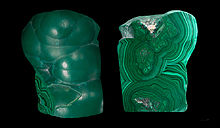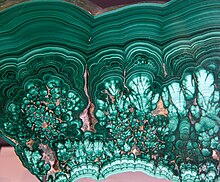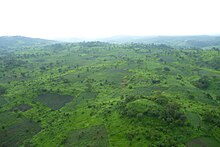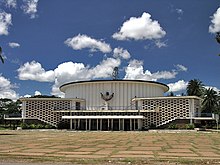Katanga Province
Katanga Province
Province du Katanga | |
|---|---|
 | |
| Coordinates: 11°08′S 27°06′E / 11.133°S 27.100°E | |
| Country | |
| Established | 1966 |
| Dissolved | 2015 |
| Capital | Lubumbashi |
| Largest city | Lubumbashi |
| Area | |
| • Total | 496,871 km2 (191,843 sq mi) |
| Population (2010 est.) | |
| • Total | 5,608,683 |
| • Density | 11/km2 (29/sq mi) |
| Demonym | Katangese |
| Official language | French |
| National languages | Swahili |


Katanga was one of the eleven provinces of the Democratic Republic of the Congo between 1966 and 2015, when it was split into the Tanganyika, Haut-Lomami, Lualaba and Haut-Katanga provinces. Between 1971 and 1997 (during the rule of Mobutu Sese Seko when Congo was known as Zaïre), its official name was Shaba Province.[1]
Katanga's area encompassed 497,000 square kilometres (49,700,000 ha). Farming and ranching are carried out on the Katanga Plateau. The eastern part of the province is considered to be a rich mining region, which supplies cobalt, copper, tin, radium, uranium, and diamonds. The region's former capital, Lubumbashi, is the second-largest city in the Congo.[2][3]
History
Copper mining in Katanga dates back over 1,000 years, and mines in the region were producing standard-sized ingots of copper for international transport by the end of the 10th century CE.[4]
In the 1890s, the province was beleaguered from the south by Cecil Rhodes' Northern Rhodesia, and from the north by the Belgian Congo, the personal possession of King Leopold II of Belgium. Msiri, the King of Katanga, held out against both, but eventually Katanga was subsumed by the Belgian Congo.[5][page needed]
After 1900, the Societe Generale de Belgique practically controlled all of the mining in the province through Union Minière du Haut Katanga (UMHK). This included uranium, radium, copper, cobalt, zinc, cadmium, germanium, manganese, silver, gold, and tin.
In 1915, a deposit of pitchblende and other uranium minerals of a higher grade than had ever been found before anywhere in the world and higher than any found since were discovered at Shinkolobwe. The discovery was kept secret by UMHK. After World War I, ended a factory was built at Olen; the secrecy was lifted at the end of 1922 with the announcement of the production of the first gram of radium from the pitchblende.[6] By the start of World War II, the mining companies "constituted a state within the Belgian Congo". The Shinkolobwe mine near Jadotville (now Likasi) was at the centre of the Manhattan Project.[7]

In 1960, after the Democratic Republic of the Congo (then called Republic of the Congo) gained independence from Belgium, the UMHK, Moise Tshombe and Godefroid Munongo supported the secession of Katanga province from the Congo. This was supported by Belgium but opposed by the Congolese Prime Minister Patrice Lumumba. This led to the assassination of Lumumba and the Katanga Crisis (or "Congo Crisis"), which lasted from 1960 to 1965. The breakaway State of Katanga existed from 1960 to 1963.[8]
In 2005, the new constitution specified that Katanga was to be split up into separately administered provinces.[9]
Militias such as Mai Mai Kata Katanga led by Gédéon Kyungu Mutanga fought for Katanga to secede, and his group briefly took over the provincial capital Lubumbashi in 2013.[8]
In 2015, Katanga Province was split into the constitutional provinces of Tanganyika, Haut-Lomami, Lualaba, and Haut-Katanga.[10][11]
Economy
Copper mining is an important part of the economy of Katanga province.[12] Cobalt mining by individual contractors is also prevalent. A number of reasons have been advanced for the failure of the vast mineral wealth of the province to increase the overall standard of living. The local provincial budget was US$440 million in 2011.[13][14]
Mining
Lubumbashi, the mining capital of the Democratic Republic of Congo, is a hub for many of the country's biggest mining companies. The Democratic Republic of Congo produces "more than 3 percent of the world’s copper and half its cobalt, most of which comes from Katanga".[15]
Major mining concessions include Tilwezembe and Kalukundi.
Mining companies
- Gécamines, (La Générale des Carrières et des Mines, the former UMHK), the state-owned copper-cobalt mining company, had monopoly concessions in the province.
- Katanga Mining Ltd TSX:KAT operates a major mining complex in Katanga province, producing refined copper and cobalt with the "potential of becoming Africa’s largest copper producer and the world’s largest cobalt producer".[16] Katanga Mining Ltd is majority-owned by Swiss commodity trader Glencore DCC.[17] A joint venture of Katanga Mining (75%) and Gécamines (25%) began mining Tilwezembe, an open-pit copper and cobalt mine, in 2007.[18]
Geography

The province formed the Congolese border with Angola and Zambia. The province also bordered Tanzania – although Katanga province and Tanzania did not share a land border – but the border was within Lake Tanganyika. Katanga has a wet and dry season. Rainfall is about 1,200 mm (49 in).[19]
Education and medical care
The University of Lubumbashi, located in the northern part of Lubumbashi city, is the largest university in the province and one of the largest in the country. A number of other university-level institutions exist in Lubumbashi, some public, some private: Institut Supérieur de Statistique, Institut Supérieur Pédagogique, Institut Supérieur des Études Sociales, Institut Supérieur de Commerce, Institut Supérieur des Techniques Médicales (all state-run), Université Protestante de Lubumbashi (Korean Presbyterian), Institut Supérieur Maria Malkia (Catholic), Institut Supérieur de Développement Mgr Mulolwa (Catholique), Theologicum St François de Sales (Salesian seminary), Institut Supérieur de Théologie Évangélique de Lubumbashi (Pentecostal/Anglican/Brethren), etc. Université Méthodiste au Katanga, the oldest private university-level institution in the province, is located at Mulungwishi (between Likasi and Kolwezi) but organizes its Masters in Leadership courses in Lubumbashi. The University of Kamina, the University of Kolwezi and the University of Likasi are former branches of the University of Lubumbashi, which continues to have branches in some locations such as Kalemie.[citation needed]
TESOL, the English Language School of Lubumbashi, is a secondary school that serves the expatriate community. It was founded in 1987 on the grounds of the French School, Lycée Français Blaise Pascal, which suspended operations in 1991 with a new French School starting in 2009.[20]
In Lubumbashi, French, Belgian, and Greek schools are sponsored by the respective embassies.[citation needed]
The Jason Sendwe Hospital is the largest hospital in the province, located in Lubumbashi. The Afia (Don Bosco) and Vie & Santé hospitals are among the best-equipped and staffed. The University of Lubumbashi maintains a small teaching hospital in the center of Lubumbashi.[citation needed]
Katanga province has the highest rate of infant mortality in the world, with 184 of 1000 babies born expected to die before the age of five.[21]

Transportation
The Congo Railway provides Katanga Province with limited railway service centered on Lubumbashi. Reliability is limited. Lubumbashi International Airport is located northeast of Lubumbashi. In April 2014, a train derailment killed 63 people.[22]
Media
Katanga province is served by television broadcasts. Radio-Télévision nationale Congolaise (RTNC) has a transmitter in Lubumbashi that re-transmits the signal from Kinshasa. In 2005, new television broadcasts by Radio Mwangaza began in Lubumbashi.[citation needed]
Notable Katangese
- Laurent-Désiré Kabila, former president of the Democratic Republic of the Congo
- Moise Tshombe, former president of the breakaway State of Katanga
- Barbara Kanam, popular singer
- Frédéric Kibassa Maliba, former opposition leader and president of UDPS
- Odilon Kafitwe wa pa Bowa, former national minister of Zaire and leader of UFERI
- Lunda Bululu, former prime minister of Zaire
- Godefroid Munongo, politician
See also
- Central African Copperbelt
- State of Katanga
- Congo Free State
- Congo Pedicle
- Msiri
- Stairs Expedition to Katanga
- Lubumbashi history and timeline
References
- ^ "Katanga | province, Democratic Republic of the Congo". Encyclopedia Britannica. Retrieved 26 February 2018.
- ^ George, Mr Francis Stevens (6 February 2014). China and Africa Love Affair. Francis Stevens George. ISBN 9781494998516.
- ^ "Biggest Cities In The Democratic Republic Of The Congo". WorldAtlas. Retrieved 26 February 2018.
- ^ Amy McKenna, ed. (2011). The History of Central and Eastern Africa. Britannica Guide to Africa. Rosen Education Service. p. 9. ISBN 978-1615303229.
- ^ Daniel Crawford (1912). Thinking Black: 22 Years Without a Break in the Long Grass of Central Africa. New York: George H. Doran.
- ^ Uranium's scientific history - Part 2
- ^ Susan Williams (2016). Spies in the Congo. New York: Public Affairs. pp. 76–77, 289. ISBN 9781610396547.
- ^ a b Maud Jullien (12 August 2013). "Fighting for DR Congo's cash cow to secede". BBC Africa. Retrieved 16 January 2019.
- ^ "Constitution de la République démocratique du Congo: Article 2". Wikisource.
- ^ The National Assembly adopts the laws regarding the limits of the provinces in the Democratic Republic of the Congo, National Assembly of the Democratic Republic of the Congo, 10 January 2015. Template:Fr icon
- ^ Election of governors: definite results expected on 18 April, Radio Okapi, 27 March 2016. Template:Fr icon
- ^ "COPPER". congo-pages.org. Retrieved 23 October 2015.
- ^ "Katanga: le budget 2011 s'élève à 396 milliards de Francs congolais". Radio Okapi. 21 September 2010. Archived from the original on 23 July 2012.
- ^ The State vs. the People: Governance, mining and the transitional regime in the Democratic Republic of Congo (PDF) (Report). Amsterdam: Netherlands Institute for Southern Africa. 2006. ISBN 90-78028-04-1.
- ^ Michael J. Kavanagh (23 March 2013). "Congolese Militia Seizes UN Compound in Katanga's Lubumbashi". Retrieved 23 March 2013.
- ^ "History: dead link". Katanga Mining. Archived from the original on 10 November 2011. Retrieved 16 November 2011.
- ^ Katanga Mining (Report).
- ^ "An Independent Technical Report on the Material Assets of Katanga Mining Limited..." (PDF). SRK Consulting. 17 March 2009. Archived from the original (PDF) on 6 May 2012. Retrieved 6 November 2011.
- ^ Katanga, or Shaba (province, Democratic Republic of the Congo) – Britannica Online Encyclopedia
- ^ English-speaking School of Lubumbashi (TESOL), page from 2007, Internet Archive, Accessed 3 March 2013.
- ^ "DR Congo eyes a greater share of its mineral riches". BBC News Online. 22 April 2012. Retrieved 22 April 2012.
- ^ "Scores killed in DR Congo train crash". Al-Jazeera. 23 April 2014. Retrieved 23 April 2014.
Bibliography
This section is empty. You can help by adding to it. (January 2018) |
